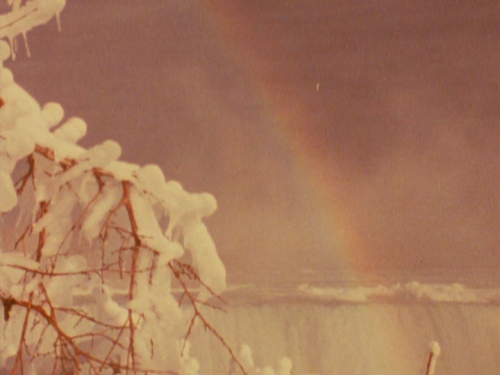
As Stan Brakhage travels through Canada and New England in the first part, studies a ‘dust devil’ or miniature tornado in Visions in Mediation 3: Plato’s Cave, makes a pilgrimage to D. H. Lawrence’s home in Taos in the fourth section, or even tries to articulate the horror felt at the spectacular Mesa Verde site in Colorado in the second piece, he films and edits with renewed energy and acuity, a vital engagement with the landscape and a depth of wonder and visual intelligence unsurpassed in all of his cinema. (P. Adams Sitney)
“Taken as a whole, the four films in the Visions in Meditation series express a vivid sense of traveling across the wide expanse of the North American Continent by car... Throughout the series of four films, the camera emphasizes the great emptiness of continental space with only a faint and fleeting sense of human presence within it, which is seen in flashes of cross-cutting. This ultimately unifying visual motif hints that the title of the series plays on the notion of mystical visions in a desert or wilderness.”
John Pruitt1
“Gertrude Stein's ‘a rose is a rose’ proposes a conception of reality that is based on the Romantic idea that God makes himself evident in the objects of nature, as the One who... comes into contact with the world of concrete particulars. Stan Brakhage, too, contrives forms that convey such theophantic beliefs. This is nowhere more evident than in Brakhage's most Steinian films, For Marilyn (1992) and the Visions in Meditation series... All these works synthesize elements that are remarkably different from one another into ‘an equitable list of... phenomena... all of them equally and simultaneously existing in perceptual fact.”
Bruce Elder2
“I have made my Visions in Meditation in homage to Gertrude Stein’s whole meditative oeuvre epitomized by her Stanzas in Meditation (1932/1956). When this series opens with an image of a white building ‘whited out’, it is not necessary to know the source of this photograph. That the structure represented (and over-exposed) is the oldest church in Maine is not relevant information with respect to the film. These formal transformations, of this once-church, now exists in a film that will realize itself through the life of shapes of white. What it referentially is, was (when photographed) crucial to my composing of it, my f-stop ‘take’ of it, the rhythms of my gradual overexposure and, later, editorial juxtaposition of it. The original cluster-of-shapes generated by this photographed church ought to cause (through shape shifts throughout) some sense of The Sacred. Each viewer, left free of my church-as-such ought to be able to build each his/her cathedral of the imagination free of architecture altogether.”
Stan Brakhage3
“Visions in Meditation springs directly from [my] Faust IV (1989) – in fact, the four parts are the fullest possible imaginable extensions of Part 4 – what the mind can do as it turns back on itself. The basic inspiration is from the poem in which Gertrude Stein tries to free words from reference and allows them to exist, each with a life of its own, within the jostling of all the words across the length of the poem. Thus “A” begins to take on a life of its own as the letter “A” or the sound “A” within the poem. You can wring a story from the life of “A” or “THE” or whatever word she introduces and repeats. But Stein didn’t merely treat words as sounds. They have very live traits as they evolve, and I tried to create a corollary of that by photographing recognizable landscapes.”
Stan Brakhage4
- 1John Pruitt, “Stan Brakhage and the Long Reach of Maya Deren’s Poetics of Film,” Chicago Review, 47/48 (Winter 2001), p. 127–28.
- 2R. Bruce Elder, The Films of Stan Brakhage in the American Tradition of Ezra Pound, Gertrude Stein, and Charles Olson (Waterloo: Wilfrid Laurier University Press, 1998): 281-282.
- 3Stan Brakhage and Bruce R. McPherson, Essential Brakhage: Selected Writings on Filmmaking (Kingston: McPherson, 2001), p. 201–2.
- 4Suranjan Ganguly, “Stan Brakhage – the 60th Birthday Interview,” Film Culture, 78 (Summer 1994), p. 2.

